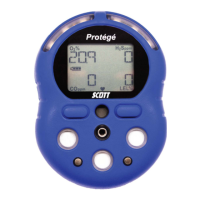Protégé Portable Gas Monitor
Instruction Manual
7 of 61
P/N 087-0038 Rev. J 02/10
1.4. General Rules for Use of the Protégé
It is critical that this gas detector be used and maintained properly. Failure to do so could jeopardize
the people whose lives depend on its operation and cause injury or death.
• USE THE MONITOR CORRECTLY! Only use the Protégé to monitor the atmosphere for the
gases and concentrations for which it is set-up to detect.
• POWER MUST BE ON TO WORK. The Protégé will only detect gases while powered on and
not while connected to the PC or in Calibration mode. Immediately charge battery when a low
battery alarm occurs.
• PERFORM A DAILY FUNCTIONAL BUMP TEST Before each day’s use, test the sensors
using a known concentration of calibration gas. The monitor should indicate a gas
concentration within 10% of the actual gas listed on the calibration cylinder label. When the
gas indication is outside the 10% limit span calibration should be performed.
WARNING
PERFORM A BUMP TEST EVERY DAY. FAILURE TO PERFORM A DAILY FUNCTIONAL TEST COULD LEAD TO SERIOUS
INJURY OR DEATH.
• BE AWARE OF Poisoned Combustible Sensors! Operation of catalytic type combustible
gas sensors may be seriously affected by silicones, free halogens, halogenated
hydrocarbons and metallic oxides present in the ambient air being monitored. If the presence
of any of these substances is suspected, increased frequency of calibration verification is
recommended.
• WHEN IN DOUBT – LEAVE THE AREA IMMEDIATELY! Users should leave the area
immediately should the Protégé indicate a warning or alarm condition. Users should know
and understand their company’s safety protocols.
• CALIBRATION IS CRITICAL! Calibration should be performed periodically that takes into
account monitor use and environment conditions.
o Additionally, the Protégé should always be re-calibrated:
After exposure to high concentrations of toxic or combustible gases or vapors.
If the monitor is dropped, or the monitor is drenched in water or submerged.
After a change in monitor custody.
• ALARMS AND OUT-OF-RANGE CONDITIONS! Operators should be aware of conditions
where the concentration of the gas is outside the detectable range of the monitor. If the
monitor indicates an over-range condition, leave the area immediately. If an over-range
condition is encountered, perform a Bump Test to ensure monitor functionality. If the monitor
fails the Bump Test, perform a full calibration procedure.

